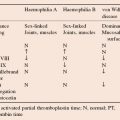Treatment
The first phase of therapy (remission induction) is with high-dose intensive combination chemotherapy to reduce or eradicate leukaemic cells from the bone marrow and re-establish normal haemopoiesis. Further therapy is post-induction chemotherapy; this is initially intensive (‘intensification’ or ‘consolidation’ chemotherapy) and then, for acute lymphoblastic leukaemia (ALL) but not acute myeloid leukaemia (AML) less intensive (maintenance chemotherapy). Each course of intensive treatment typically requires 4–6 weeks in hospital. Complications of chemotherapy and supportive care are considered in Chapter 21; blood component therapy is considered in Chapter 49.
Acute myeloid leukaemia
Remission induction regimes usually comprise an anthracycline (e.g. daunorubicin), cytosine arabinoside (ara-C) and, in some protocols, etoposide. Fludarabine combined with high doses of ara-C and granulocyte colony-stimulating factor (G-CSF) (FLAG) may also be used for induction. All-trans retinoic acid (ATRA) is given with an anthracycline or arsenic trioxide in acute promyelocytic leukaemia (APML) to induce remission.
Stay updated, free articles. Join our Telegram channel

Full access? Get Clinical Tree




